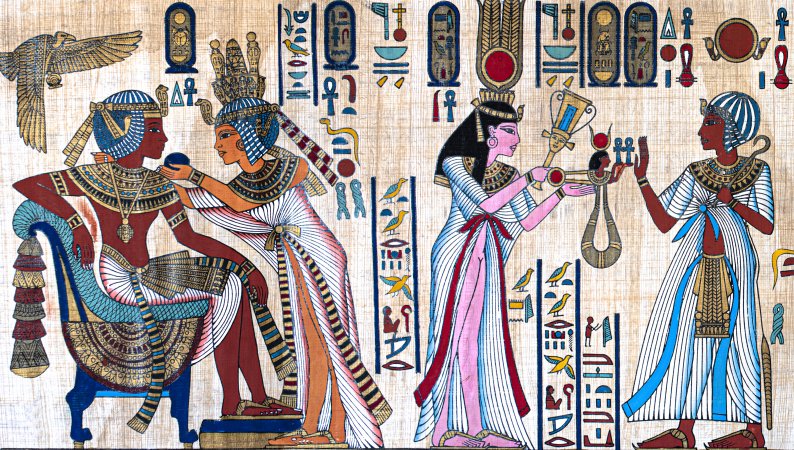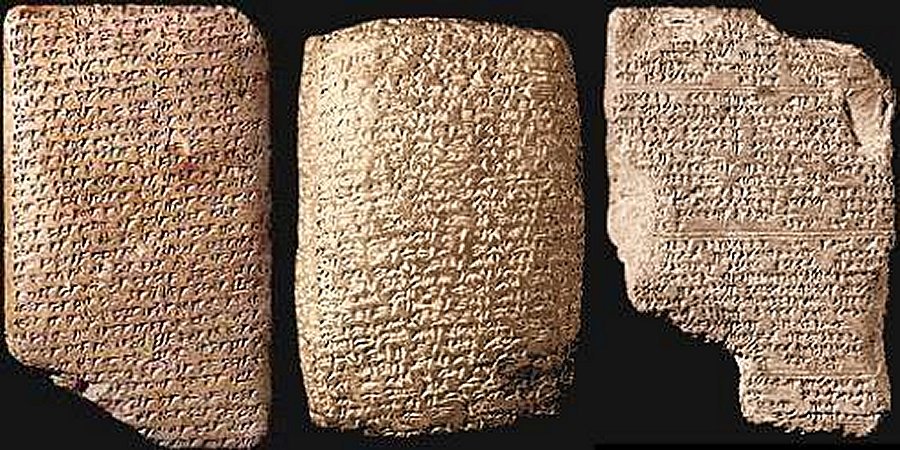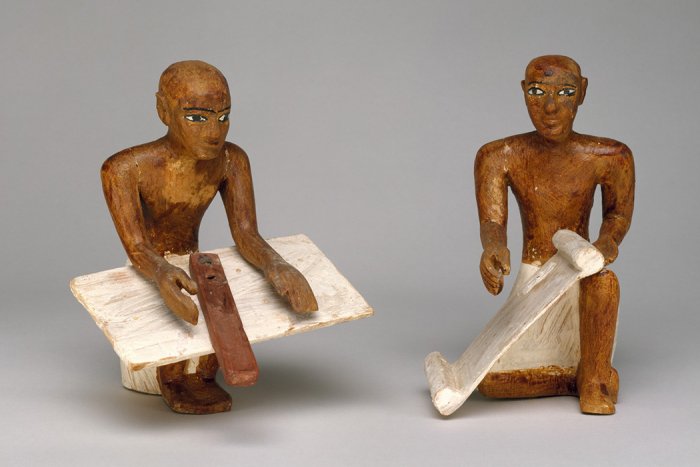Letters Reveal How Ancient Egyptians Argued With Friends And What Angered Them
Ellen Lloyd - AncientPages.com - As time passes, every society changes one way or the other, but some things, like human behavior, will always remain the same, more or less. Feelings like anger, disappointment, frustration, and happiness are universal and independent of time and place.
Ancient peoples’ values may have changed, but negative and positive feelings will always be part of human nature.

Ancient Egyptians had the same feelings as we today, and could be angry, frustrated, or simply just happy. Credit: AliaksandrBS - Adobe Stock
By studying several letters from Deir el-Medina, a village comprising artisans working on pharaonic tombs, Egyptologist Deborah Sweeney has gained a unique insight into how ancient Egyptians expressed frustration, confusion, and anger to friends or family members.
“Although Papyri Deir el-Medina IV, V and VI have been published, translated and included in anthologies of Egyptian texts, their interest is by no means exhausted. Not only do these texts contain interesting observations on friendship, which help us understand how the ancient Egyptians understood this relationship, they also increase our awareness of what the Egyptians actually did when they quarreled and made up. This study forms part of a wider research project on the themes of sin, forgiveness, and punishment in ancient Egypt as reflected in everyday texts such as personal correspondence.” 1
Whether political, military or purely personal, studying ancient correspondence provides valuable knowledge about human relationships.
Studies of 382 known clay cuneiform tablets, known as the Amarna Tablets, or simply Amarna Letters as they are called these days, have proven important to understand ancient Egyptians’ contacts with their neighbors.

Examples of "The Amarna Letters" were discovered in 1887. There are 382 known clay cuneiform tablets, whose contents shed light on Egyptian relations with Babylonia, Assyria, Mitanni, the Hittites, Syria, Palestine and Cyprus. They are important for establishing both the history and chronology of the period. Credit: EgyptOnline.com
The Amarna Letters are mostly diplomatic letters (with a few myths and epics) dated to an interesting historical period in ancient Egypt, related to the reigns of pharaoh Akhenaten of the 18th Dynasty of Egypt and his wife Nefertiti, and Amenhotep III (1402-1364). The tablets “deal with a variety of subjects, such as exchange of gifts between rulers, news about events in distant Phoenician cities: Byblos, Tyre, various requests regarding food, military affairs, and diplomatic marriages.” 2
The Amarna Letters are of great historical value, but it’s also very interesting to learn how ordinary people interacted with their friends and family.
The ancient letters studied by Sweeney reveal how people reacted when they were ignored or someone did not keep their part of the bargain. One ancient writer complained about failing as a friend. Another one was disappointed someone hadn’t been in touch for long.
Just like in our modern society, ghosting friends and ignoring agreed-upon favors acted as violations of the “social obligations” of friendship.”
 Scribes from Meketre's Model Granary ca. 1981–1975 B.C. Credit: MET
Scribes from Meketre's Model Granary ca. 1981–1975 B.C. Credit: MET
One Egyptian scribe, “named Nakhtsobk writes to “the crew member Amennakhte.” After hailing his longtime friend and wishing him well, Nakhtsobk says plaintively, “What offence have I done against you? Aren’t I your old eating companion?”
Nakhtsobk doesn’t understand what he’s done wrong for Amennakhte to ignore him and, in fact, try to get him banned from the entire village. This is hardly Nakhtsobk’s understanding of being a good friend! What could have caused Ammenakhte to not only discard their longstanding bond but to actively try to keep Nakhtsobk out of his town? We’ll never know, but such a severe action, to sever a friendship, is one that’s all too timeless.” 3
In another letter, an anonymous writer expresses frustration asking, “What’s the matter with you?” The writer snarks that he’s never been able to understand the addressee’s behavior.” 3
It seems the writer has assumed that “friends care for each other, help one another out and comply with each other’s requests,” Sweeney notes—a social contract the addressee has violated.
Yet, another writer, whose name we do not know, “ tells the addressee that a woman—likely someone related to, or associated with, the addressee—has run away to Deir el-Medina and he has taken her in. He’s asking the addressee for rations—ointment, in this case—to support his new guest; the addressee hasn’t looked after the woman well in the past, he says, and admonishes the addressee to do better going forward. Finally, the writer complains that he‘s always the one who invests time and writes to the addressee—but never vice-versa.” 3
Studies of such ancient correspondence show much, and yet little has changed in society. Social interactions with friends and family can sometimes lead to misunderstandings, disappointments, and broken promises, and whenever it happens, people express their emotions in letters. The ancient Egyptian letters constitute universal behaviors in every human society.
Written by Ellen Lloyd – AncientPages.com
Expand for references- Sweeney, Deborah. "Friendship and Frustration: A Study in Papyri Deir El-Medina IV-VI." The Journal of Egyptian Archaeology84 (1998): 101-22. Accessed October 18, 2020.
- Sutherland - The Amarna Letters: Diplomatic Correspondence In Ancient Egypt – AncientPages.com
- Carly Silver - How to Fight with Friends in Ancient Egypt, JStor Daily
More From Ancient Pages
-
 Anglo-Saxon Harpole Treasure Reveals More Secrets – Unique Medieval Silver Cross Found
Archaeology | Jan 31, 2023
Anglo-Saxon Harpole Treasure Reveals More Secrets – Unique Medieval Silver Cross Found
Archaeology | Jan 31, 2023 -
 Oldest Lunar Calendar Engraved On A Pebble Dated To 10,000 Years Ago
Archaeology | Aug 5, 2019
Oldest Lunar Calendar Engraved On A Pebble Dated To 10,000 Years Ago
Archaeology | Aug 5, 2019 -
 Remarkable Giant Minoan Structure Found On Top Of Papoura Hill, Crete
Archaeology | Jun 11, 2024
Remarkable Giant Minoan Structure Found On Top Of Papoura Hill, Crete
Archaeology | Jun 11, 2024 -
 New West Papua Findings Provide Insights Into Early Human Migration To The Pacific
Featured Stories | Aug 13, 2024
New West Papua Findings Provide Insights Into Early Human Migration To The Pacific
Featured Stories | Aug 13, 2024 -
 Mysterious Ancient “Fish People” – Who Were They And How Did They ‘Change’ Civilizations Worldwide?
Ancient Mysteries | Dec 20, 2021
Mysterious Ancient “Fish People” – Who Were They And How Did They ‘Change’ Civilizations Worldwide?
Ancient Mysteries | Dec 20, 2021 -
 Is Biblical Mount Sinai Located In Har Karkom Where Mesopotamian Moon God Sin Was Worshipped?
Biblical Mysteries | Mar 20, 2017
Is Biblical Mount Sinai Located In Har Karkom Where Mesopotamian Moon God Sin Was Worshipped?
Biblical Mysteries | Mar 20, 2017 -
 Mysterious Megaliths Of Russia May Offer Evidence Of An Ancient Advanced Lost Civilization
Ancient Technology | Jul 22, 2017
Mysterious Megaliths Of Russia May Offer Evidence Of An Ancient Advanced Lost Civilization
Ancient Technology | Jul 22, 2017 -
 Rare 2,500-Year-Old Saw Discovered At The Ancient Hittite City Hattusa
Archaeology | Nov 27, 2023
Rare 2,500-Year-Old Saw Discovered At The Ancient Hittite City Hattusa
Archaeology | Nov 27, 2023 -
 Evidence Humans Walked The Great Plains 18,000 Years Ago May Have Been Found – Archaeologists Say
Archaeology | Mar 14, 2022
Evidence Humans Walked The Great Plains 18,000 Years Ago May Have Been Found – Archaeologists Say
Archaeology | Mar 14, 2022 -
 Rare Bronze Oil Lamp With A Face Cut In Half Unearthed In Israel
Archaeology | May 7, 2021
Rare Bronze Oil Lamp With A Face Cut In Half Unearthed In Israel
Archaeology | May 7, 2021 -
 7 Magnificent Thracian Gold Bracelets Found In Romanian Forest By Amateur Archaeologist
Archaeology | May 23, 2023
7 Magnificent Thracian Gold Bracelets Found In Romanian Forest By Amateur Archaeologist
Archaeology | May 23, 2023 -
 Code Of Chivalry: ‘Knightly’ Behavior, Courageous Medieval Knights, Warriors And Superior Men
Featured Stories | Jun 5, 2016
Code Of Chivalry: ‘Knightly’ Behavior, Courageous Medieval Knights, Warriors And Superior Men
Featured Stories | Jun 5, 2016 -
 A 4,500-Year-Old Collective Tomb In France Reveals Its Secret – The Final Stage In The Formation Of The ‘European Genome’
Featured Stories | Jul 5, 2024
A 4,500-Year-Old Collective Tomb In France Reveals Its Secret – The Final Stage In The Formation Of The ‘European Genome’
Featured Stories | Jul 5, 2024 -
 Huge Number Of Intact, Painted Coffins In Shafts Of Egypt’s Saqqara Necropolis
Archaeology | Nov 13, 2020
Huge Number Of Intact, Painted Coffins In Shafts Of Egypt’s Saqqara Necropolis
Archaeology | Nov 13, 2020 -
 Underground World Of Cerra Naztarny Where The Navajo And White People Once Lived Peacefully Together
Featured Stories | May 29, 2021
Underground World Of Cerra Naztarny Where The Navajo And White People Once Lived Peacefully Together
Featured Stories | May 29, 2021 -
 Mystery Of 3,000-Year-Old African Civilization Garamantes And Its Ancient Secrets
Archaeology | Feb 16, 2015
Mystery Of 3,000-Year-Old African Civilization Garamantes And Its Ancient Secrets
Archaeology | Feb 16, 2015 -
 Oldest Footprints Of Pre-Humans Discovered In Crete – They Are 6 Million-Year-Old!
Archaeology | Oct 12, 2021
Oldest Footprints Of Pre-Humans Discovered In Crete – They Are 6 Million-Year-Old!
Archaeology | Oct 12, 2021 -
 Battle Of Abrittus: Roman Emperor Decius And His Troops Ambushed And Defeated By Invading Goths
Featured Stories | Jul 1, 2019
Battle Of Abrittus: Roman Emperor Decius And His Troops Ambushed And Defeated By Invading Goths
Featured Stories | Jul 1, 2019 -
 Archaeologists Solve A 1,000-Year-Old Mystery Mentioned In Norse Sagas
Featured Stories | Oct 10, 2024
Archaeologists Solve A 1,000-Year-Old Mystery Mentioned In Norse Sagas
Featured Stories | Oct 10, 2024 -
 Ruins Of A Roman-Era Bath And A Floor Mosaic Discovered In Central Anatolia
Archaeology | Dec 28, 2015
Ruins Of A Roman-Era Bath And A Floor Mosaic Discovered In Central Anatolia
Archaeology | Dec 28, 2015
